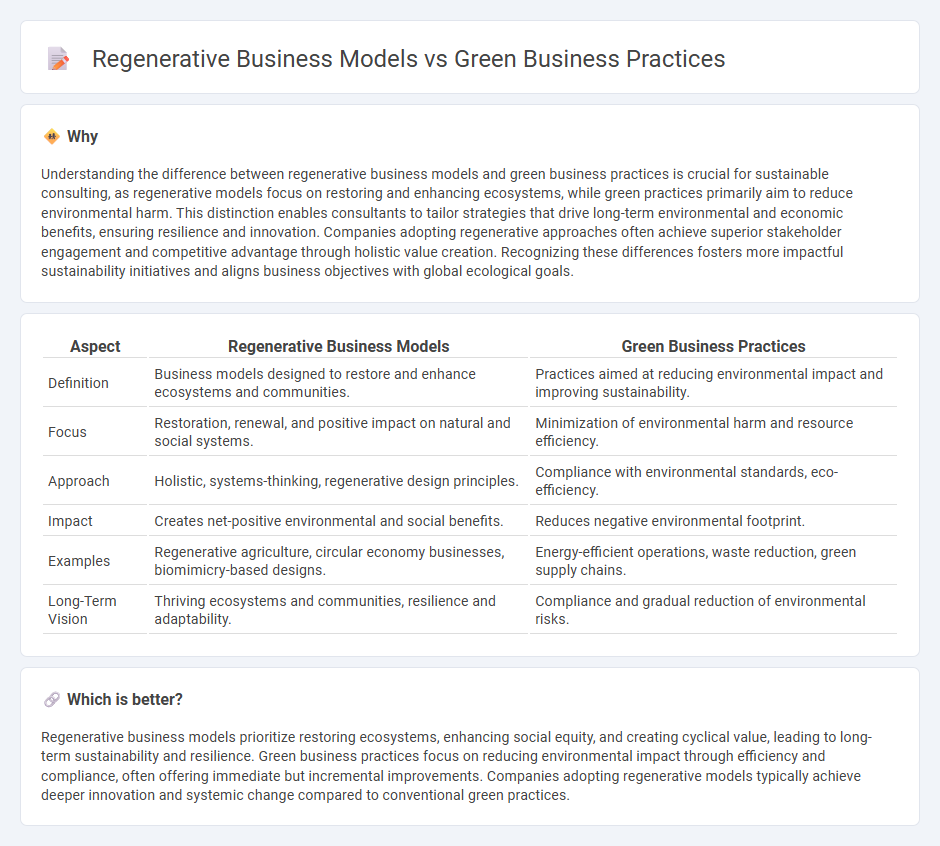
Regenerative business models focus on restoring and enhancing ecosystems while creating economic value, embedding sustainability into the core of business strategy rather than treating it as a supplementary goal. In contrast, green business practices often emphasize reducing environmental impact through efficiency improvements and compliance with eco-friendly standards. Explore how these innovative approaches transform industries and foster long-term resilience.
Why it is important
Understanding the difference between regenerative business models and green business practices is crucial for sustainable consulting, as regenerative models focus on restoring and enhancing ecosystems, while green practices primarily aim to reduce environmental harm. This distinction enables consultants to tailor strategies that drive long-term environmental and economic benefits, ensuring resilience and innovation. Companies adopting regenerative approaches often achieve superior stakeholder engagement and competitive advantage through holistic value creation. Recognizing these differences fosters more impactful sustainability initiatives and aligns business objectives with global ecological goals.
Comparison Table
| Aspect | Regenerative Business Models | Green Business Practices |
|---|---|---|
| Definition | Business models designed to restore and enhance ecosystems and communities. | Practices aimed at reducing environmental impact and improving sustainability. |
| Focus | Restoration, renewal, and positive impact on natural and social systems. | Minimization of environmental harm and resource efficiency. |
| Approach | Holistic, systems-thinking, regenerative design principles. | Compliance with environmental standards, eco-efficiency. |
| Impact | Creates net-positive environmental and social benefits. | Reduces negative environmental footprint. |
| Examples | Regenerative agriculture, circular economy businesses, biomimicry-based designs. | Energy-efficient operations, waste reduction, green supply chains. |
| Long-Term Vision | Thriving ecosystems and communities, resilience and adaptability. | Compliance and gradual reduction of environmental risks. |
Which is better?
Regenerative business models prioritize restoring ecosystems, enhancing social equity, and creating cyclical value, leading to long-term sustainability and resilience. Green business practices focus on reducing environmental impact through efficiency and compliance, often offering immediate but incremental improvements. Companies adopting regenerative models typically achieve deeper innovation and systemic change compared to conventional green practices.
Connection
Regenerative business models integrate green business practices by prioritizing environmental restoration and sustainable resource management to create long-term ecological and economic value. These models focus on circular economy principles, reducing waste, and enhancing biodiversity, which aligns with green practices aimed at minimizing carbon footprints and promoting renewable energy. Together, they drive innovation in consulting by helping organizations transition to sustainable operations that support both profit and planet health.
Key Terms
Sustainability
Green business practices emphasize reducing environmental impact through energy efficiency, waste reduction, and sustainable sourcing, aligning with traditional sustainability goals. Regenerative business models go beyond by restoring and enhancing ecosystems, promoting circular economies, and improving social well-being while ensuring long-term resilience. Explore innovative strategies that transform sustainability efforts into regenerative outcomes for a thriving planetary future.
Circular Economy
Green business practices emphasize reducing environmental impact through resource efficiency and waste minimization, often aligning with circular economy principles such as recycling and sustainable sourcing. Regenerative business models go beyond sustainability by actively restoring ecosystems, enhancing biodiversity, and creating positive social value within the circular economy framework. Explore the transformative potential of regenerative models to redefine business success and environmental stewardship.
Regenerative Design
Green business practices emphasize reducing environmental harm through energy efficiency and waste minimization, whereas regenerative business models prioritize restoring and enhancing ecosystems by integrating regenerative design principles. Regenerative design goes beyond sustainability by creating systems that renew natural resources, promote biodiversity, and foster resilient communities. Discover how regenerative design transforms business strategies for long-term ecological and economic benefits.
Source and External Links
Becoming an environmentally friendly business - Small businesses can adopt water recycling, use products made from recycled materials, and increase waste recycling to support a circular economy and reduce environmental impact.
Sustainable business - Wikipedia - Sustainable businesses implement green strategies such as going paperless, refurbishing used products, and using non-toxic materials to minimize ecological harm and carbon footprint.
7 Sustainability Ideas To Green Up Your Small Business - Ideas include engaging employees in sustainability efforts, switching to renewable energy, and adopting green procurement policies to make operations more eco-friendly.
 dowidth.com
dowidth.com